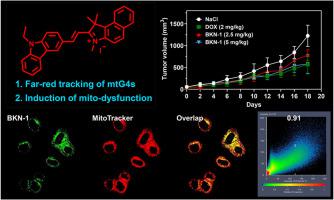European Journal of Medicinal Chemistry ( IF 6.0 ) Pub Date : 2023-12-13 , DOI: 10.1016/j.ejmech.2023.116046 Zhigang Wang 1 , Jianghong Zhou 1 , Long Lin 1 , Ming-Hao Hu 1

|
G-quadruplex (G4) formation was considered to be more prevalent in the mitochondrial DNA (mtDNA) of cancer cells compared with normal cells. Stabilization of these G4s may induce mtDNA instability and cause mitochondrial dysfunction and subsequent cell death, which may be treated as a new strategy for cancer treatment. However, few ligands were developed to target mtG4s, leaving a huge room to improve. In this study, we designed and synthesized a series of carbazole-based ligands, among which, BKN-1 was identified as the most promising mitochondrial targeting fluorescent ligand with far-red emission. Then, we demonstrated that BKN-1 may robustly interact with mtG4s via a variety of biophysical, biological experiments. Subsequently, we proved that BKN-1 may cause mtDNA loss, disrupt mitochondrial integrity, decrease ATP level and trigger unbalanced ROS, thereby leading to apoptosis and autophagy. Finally, we verified that BKN-1 had good anti-tumor activity in both cellular and in vivo models. Altogether, this study provided a dual-function ligand that may not only track the formation of mtG4s but also induce mitochondrial dysfunction, which may be developed into an applicable chemical tool for investigating the structure and function of mtG4s, and moreover, an effective therapeutic agent for cancer interference.
中文翻译:

发现远红咔唑-苯并吲哚荧光配体,选择性靶向线粒体 DNA 并抑制乳腺癌生长
与正常细胞相比,癌细胞的线粒体 DNA (mtDNA) 中 G-四链体 (G4) 的形成更为普遍。这些 G4 的稳定可能会引起 mtDNA 不稳定并导致线粒体功能障碍和随后的细胞死亡,这可能被视为癌症治疗的新策略。然而,针对 mtG4 的配体很少被开发出来,这留下了巨大的改进空间。在本研究中,我们设计并合成了一系列基于咔唑的配体,其中BKN-1被认为是最有前途的远红发射线粒体靶向荧光配体。然后,我们通过各种生物物理、生物实验证明了BKN-1可以与 mtG4 强有力地相互作用。随后,我们证明BKN-1可能导致mtDNA丢失、破坏线粒体完整性、降低ATP水平并引发ROS失衡,从而导致细胞凋亡和自噬。最后,我们验证了BKN-1在细胞和体内模型中均具有良好的抗肿瘤活性。总而言之,这项研究提供了一种双功能配体,不仅可以追踪mtG4s的形成,还可以诱导线粒体功能障碍,它可以开发成一种适用的化学工具来研究mtG4s的结构和功能,此外,它还可以成为一种有效的治疗剂用于癌症干扰。


















































 京公网安备 11010802027423号
京公网安备 11010802027423号